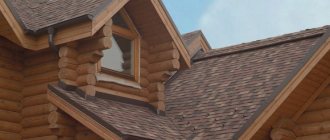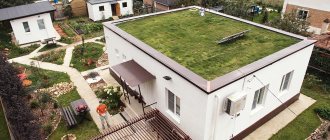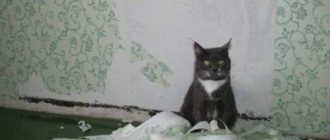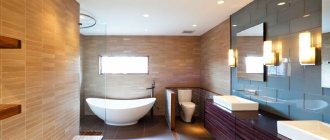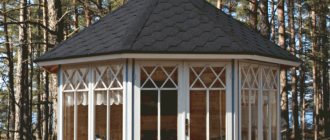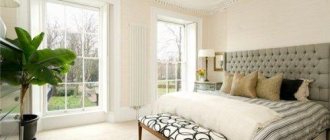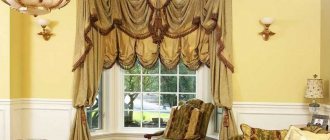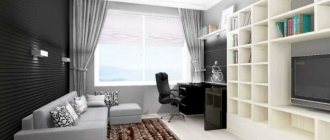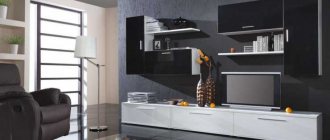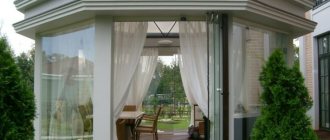Asbestos cement slate
Asbestos-cement slate is a practical, reliable and affordable building material made from cement components, and for additional strength, manufacturers have equipped it with asbestos fibers. Slate consists of 15% asbestos and 85% Portland cement.
Options:
- operational life - 25 years;
- dimensions - 1.2x0.7 m;
- weight - 9.5-16 kg/sq. m.
Pros:
- relative strength;
- ease of installation;
- combustion resistance;
- cheapness.
Minuses:
- with strong impacts the material may crack;
- heavy weight;
- moisture absorption.
The average price in Russia ranges from 120 to 240 rubles per 1 sq. m. m. For example, if you want to cover a roof with an area of 100 square meters. m., then it will cost 24,000 rubles excluding the cost of fasteners.
Using special paints, asbestos cement slate can be painted in a preferred color that would blend well with the house. The palette is rich, so there is plenty to choose from.
Metal
Today this material is the most common. The advantages of metal coating include hygiene, high strength, fire resistance and low weight. Among the disadvantages, it is worth noting susceptibility to corrosion, good heat and sound conductivity. In the production of the material, both sheet and piece raw materials are used: steel, duralumin, copper and gold-plated plates, stamped metal tiles. To install the coating, it is necessary to involve specialists. The most popular today are galvanized and iron sheets. They are coated with a special protective layer of an alloy of copper, titanium and zinc, which prevents corrosion.
Euroslate
Euroslate refers to ondulin or ethernit. The materials are externally identical, differing only in composition, size and weight. Eternite is made in segments measuring 70-80 cm and consists of asbestos cement and polymer fibers. The building material is foreign and costs a little more than classic ondulin.
Ondulin is made from polymers, and its structure is formed by ultra-thin cellulose fibers treated with special additives and bitumen. This roofing building material is covered in several layers of a protective polymer solution.
Options:
- waves 3.6 cm high;
- dimensions - 2x0.96 m;
- weight - 6.5 kg/sq. m.
Pros:
- moisture resistance;
- environmental friendliness;
- long service life;
- a light weight.
Minuses:
- fragility;
- burns at a temperature of 110 degrees Celsius;
- The paint layer fades quickly.
If the roof is damaged and elements need to be replaced, then it is not so easy to walk on it, since the building material can crack under the weight of a person. You will have to make special stairs. However, the great advantage of Euro slate roofing is its noiselessness. During heavy rain, you will not hear the sounds of drops crashing on the roof. The average price of such coverage is 170-200 rubles per 1 sq. m. m.
Auxiliary materials required for roof installation
In addition to the actual roof, its construction will require a large number of auxiliary materials: accessories, components, additional tools. This list includes:
- ventilation;
- drain;
- under-roofing films (steam and waterproofing elements, ridge tape);
- OSB board;
- seals;
- insulation;
- additional elements;
- “consumables” like hardware (bolts and screws).
In monetary terms, all of the additional products listed are worth a lot. Therefore, it must be included in the estimate, otherwise the cost calculation will be inaccurate. There are often cases when the price of auxiliary materials for the roof is even higher than the base itself. Please note: each type of roofing material requires a specific set of components, which can vary significantly in the list of elements and quantity.
Drainage system
The drainage system serves to effectively drain precipitation into storm drains. In the selection process, primary attention should be paid to the material (steel, copper, plastic), geometry and diameter of the drainpipe, resistance to mechanical loads, and the ratio of the chemical composition of a number of drainage systems and the roof.
Roof ventilation
In a private residential building, the issue of organizing ventilation is given great importance. The quality of its execution determines the absence of condensation in the roofing “pie”, maintaining temperature balance, removing water vapor from the premises, reducing the likelihood of overheating of the roof in summer, the absence of freezing in winter and extending the life of the entire roof. When choosing the appropriate option (natural or forced), you should be guided by the type of roof and structural features. The list of main components includes roof vents, ventilation outlets and passage elements. The first element ensures the integrity of the system and also helps remove condensate. Thanks to the valves, natural air enters the room and the resulting moisture is removed. Pass-through ventilation elements help improve the tightness and reliability of ventilation.
Under-roof waterproofing and vapor barrier films and membranes
The under-roof covering in the form of special films serves as additional protection against moisture ingress into the roof and under it (both from the outside and from the inside). The most preferable products are those characterized by both high waterproofing parameters and optimal vapor permeability. The main materials for the production of roofing films are polyethylene and polypropylene. In addition to the material, the differences lie in the structure and functions performed. When choosing a suitable option, it is recommended to adhere to parameters related to vapor permeability and strength.
OSB / OSB board
The purpose of oriented strand board is to create continuous decks on pitched roofs, as well as slope-forming load-bearing foundations for flat roofs. Depending on the type and manufacturer of the OSB board, the length of the chips, the type of binder, compaction density and other important indicators may vary. You should choose one or another option based on the design and parameters of the roof being built. Among the key points are the strength and moisture resistance of the slabs. In a number of collections there are polished surfaces; in other models, special corrugation can be applied, which allows for better adhesion with other materials and promotes more reliable movement during roof installation.
Roof insulation
Thermal insulation of a roof is difficult to imagine without the use of insulation. These are materials that allow you to create a reliable and effective thermal insulation barrier. It will be able to guarantee optimal temperature conditions inside the living space throughout the year. We should not forget that high-quality insulation, in addition to its main function, can prevent (“dampen”) the propagation of sound vibrations. When choosing a suitable option, it is recommended to focus on the parameter of heat transfer resistance (thermal conductivity coefficient), low specific density, low hygroscopicity, lack of biological decomposition, low flammability and other characteristics.
Rolled bitumen roofs
This is the cheapest roofing option - you can cover the roof with such material at minimal cost. Roofing felt is produced in the form of rolls. Durable cardboard is used as a basis and bitumen is applied on both sides. The front side of the coating is sprinkled with crumbs.
There are different types of rolled bitumen building materials at different prices. The most expensive is Aquaizol - this roofing is thick and viscous. Install aquaizol by fusing. And the cheapest options are good for a couple of seasons, then the coating will have to be changed.
Options:
- thickness - 1-4 mm;
- length - 10-20 m;
- width - 1 m;
- weight - 1-4 kg/sq. m.
Pros:
- cheapness;
- ease of installation - can be nailed or fused;
- ease.
Minuses:
- bitumen roofing is highly flammable;
- At extreme temperatures it melts.
Fusing bitumen roll roofing in 2 layers will provide good waterproofing. However, it will take two people to install such material. The price of roofing felt is 30-100 rubles per 1 sq. m. m.
Copper and aluminum roofing
This aluminum and copper material is manufactured in sheets weighing from 5 to 10 kilograms. It is possible to choose roofing sheets of different sizes, which makes installation work somewhat easier.
The advantages of such a seam copper and aluminum roof include its attractive appearance and resistance to corrosion. Copper soon after its installation becomes covered with a patina, and the structure itself acquires an original noble appearance. Among the disadvantages, we note the need for additional insulation and sound insulation of the roof, as well as the high cost of such materials.
Flexible tiles
This is a modernized bitumen roofing that is produced in the form of tiles. The material consists of fiberglass treated with bitumen, polymers, basalt or slate chips, which decorate and protect the tiles from exposure to ultraviolet rays. Soft roofing is designed to cover complex roofs with slopes and transitions.
Options:
- sizes - 10-30 cm;
- there are types with rectangular and rounded edges;
- weight - 8-12 kg/sq. m.
Pros:
- good sound insulation;
- aesthetics;
- plastic;
- condensation and corrosion do not form;
- long service life.
Minuses:
- labor-intensive installation;
- flammability of the material;
- In severe frosts, bitumen cracks.
If installed correctly, soft tiles will last for several decades, since the bitumen itself is durable. The average price of such a roof is 220-260 rubles per 1 sq. m. m.
Bitumen fiber sheet
This material for roofing the roof of a house has another name - “Euro slate”. It is analogous to the coating described above. Euroslate belongs to the category of modern materials. In Russia, a common name for this coating is ondulin (after a popular brand). The shape of the sheets is similar to slate. A distinctive feature of ondulin is its ease of processing and higher strength. The coating is light in weight. This allows you to lay it on the roof without removing the previous material and without strengthening the rafter system. Euro slate sheets can withstand gusts of wind and snow loads. Another analogue is a coating, in the manufacture of which a homogeneous polymer is used. The extrusion method is used in production. Also during the manufacturing process, the sheets are corrugated. The advantages of this coating are strength, light weight, fire resistance, resistance to acidic and alkaline environments, environmental friendliness, variety of shades and durability. However, such material can be laid on a roof with a slope of at least 15%.
Corrugated sheet
This is a roofing material that can be used to inexpensively cover the roof of a house or cottage. Corrugated sheets are mainly made of zinc, but there are types with a polymer protective coating, which increases their service life. The waves on the building material are not round, like on ordinary slate, but rectangular, so joining between sheets is easy.
Options:
- thickness - 0.8-4.4 mm;
- dimensions - 1.15-1.19 m;
- weight - 4-9 kg/sq. m.
Pros:
- cheapness;
- strength;
- ease of installation;
- long service life.
Minuses:
- noisiness;
- Damage to the protective coating may lead to corrosion;
- sheathing required.
Corrugated sheeting is an analogue of metal tiles, only several times cheaper. It is much better than roll roofing. The average cost of such coverage is 150-250 rubles per 1 sq. m. m.
What is the cheapest roofing material?
It’s not for nothing that private housing developers are looking for the cheapest roofing material. After all, the cost factor plays an important role when choosing a suitable roof. However, the economical price should not come to the fore without taking into account other factors: the architectural structure of the roof, the purpose of the building, the weight of the roofing material and the budget allocated for these purposes. That is, one should always proceed from the best price/quality ratio.
When choosing a roofing material, you need to take into account the architecture of the roof, the purpose of the building, the weight of the material and its cost.
One cannot discount the fact that the load from the roof consists not only of the weight of the rafters and roofing material, but also in winter from the weight of the snow falling on the roof and from the constant wind loads in the area. For central Russia, the last two indicators are usually taken equal to 200 kg per sq. m. The angle of inclination of the slope should also be taken into account.
How to cover the roof of a house so that everything suits you and is cheaper? Having familiarized yourself with the variety of existing coatings on the market, the choice will not be so difficult.
Requirements for roofing.
Roofing material must be:
- high strength;
- durable;
- resistant to atmospheric conditions (frost, heat, moisture, solar radiation, oxygen);
- good sound and heat insulator;
- anti-corrosion;
- fire resistant.
What is a roof?
The roofing system is a part of the roof, which is a set of materials arranged in a certain sequence and clearly selected for each specific case. The roof composition includes:
- load-bearing layers - solid flooring, screeds and sheathing, which are supported on the rafters that form the basis of the roof’s load-bearing system;
- insulation materials - steam, heat and waterproofing, as well as lining carpet;
- covering material - the top visible layer.
The roof performs a protective and decorative function. It protects the building from the negative effects of the environment, collects and drains melt water and precipitation, and also, thanks to the roofing, makes the house attractive.
Any roof has an incredibly important task - throughout its entire service life it must protect the home from the vagaries of nature and maintain an attractive appearance
Since it is the covering flooring that is directly exposed to heavy snowfalls, heavy winds and heavy rains, special requirements are placed on it:
- fire safety;
- waterproof;
- resistance to ultraviolet radiation, corrosion, mechanical stress, aggressive chemicals, static and temperature loads.
